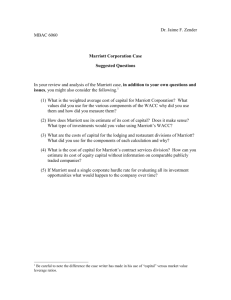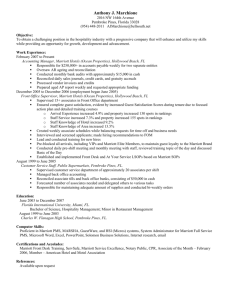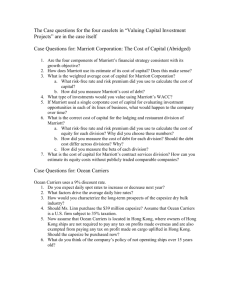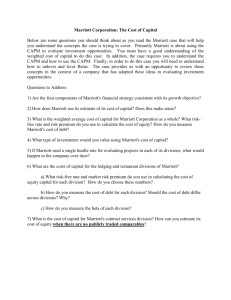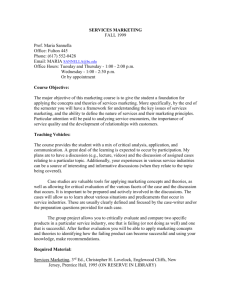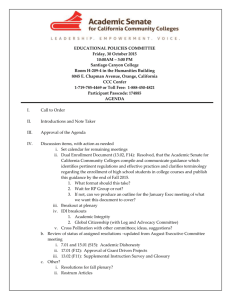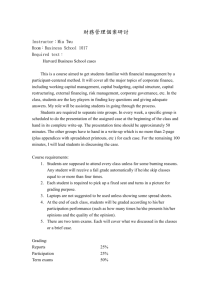BMC Software Customer Marriott Showcases IT Thought
advertisement
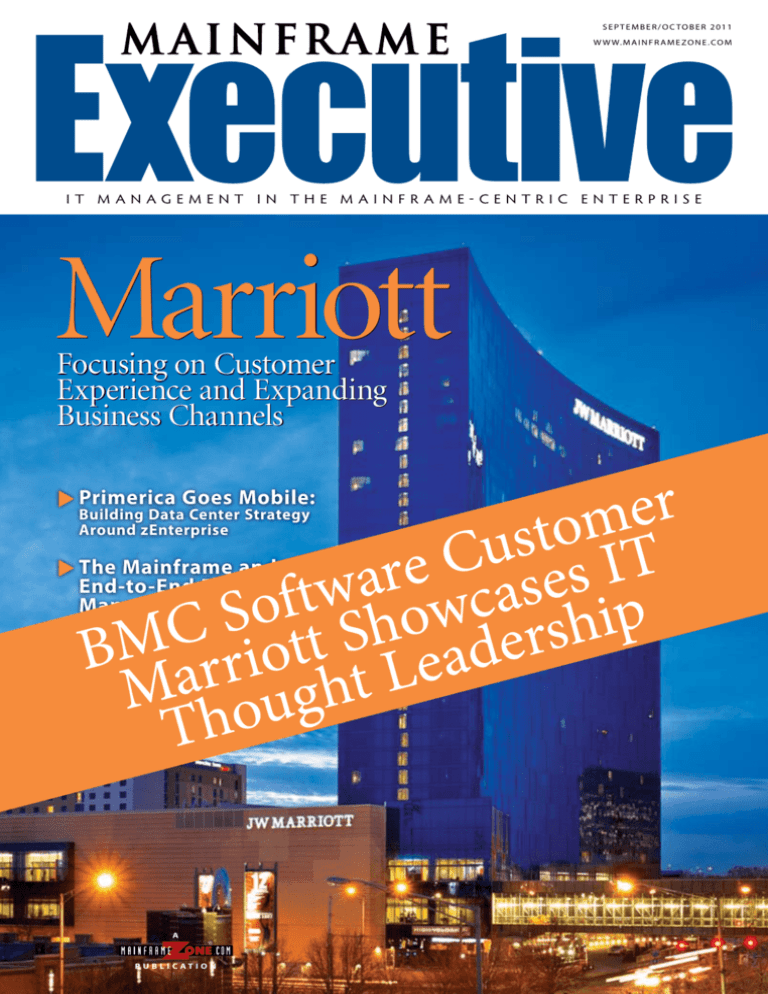
SEPTEMBER/OC TOBER 2011 w w w. M a i n f r a me Z o n e . com IT M anagem ent IN the M ainfr a m e-centric enterprise Marriott Focusing on Customer Experience and Expanding Business Channels r e m o t s u C T I e r s a e s w a t f c o w p S i o h h C s BM arriott S Leader M ought Th Primerica Goes Mobile: Building Data Center Strategy Around zEnterprise The Mainframe and End-to-End Energy Management Driving E+H: System z Supports the Swiss Industrial Conglomerate’s Worldwide Business A P U B L I C AT I O N Marriott The Ritz-Carlton, Hong Kong (above), and the Miami Marriott Biscayne Bay (right) Focusing on Customer Experience and Expanding Business Channels By Mary E. Shacklett Mainframe Exec utive | S eptember / O c to b e r 2 0 1 1 ith more than 3,500 lodging properties in the U.S. and 69 other countries and territories, revenue of nearly $12 billion for 2010 and a daily workload of more than 750,000 new reservations, Marriott is one of the largest hospitality companies in the world. The demands on its hotel reservation system are enormous. Transaction throughput must be rapid and unfailing, non-stop, from anywhere. If problems arise, failover must be swift and absolute. The customer experience and Business Intelligence (BI) systems must be able to “right fit” pricing and accommodations for customers because they’re integral to achieving and maintaining competitive advantage. Marriott must also be able to extend its reach to customers. To do this, it must be able to offer reservations processing on its own Website as well as make this online reservations processing capability available to the Websites of its various business channel partners around the world. “One of our goals is to increase the number of strategic distribution channels for our inventory,” says Misha Kravchenko, vice president, Global Enterprise Mainframe Systems for Marriott International. “The increased use of the Internet around the world enables Marriott to expand distribution opportunities.” Marriott also has other business goals for its inventory of accommodations. It wants to optimize the customer experience. This means instantaneous order fulfillment at any time from any point and best pricing for any given location, coupled with the ability for Marriott Rewards customers to capitalize on the special qualities of that relationship. Marriott also wants to optimize occupancy rates. Marriott processes an average of 1,500 transactions per second. Ninety-nine percent of all transactions take less than one second, regardless of where you are in the world. “Many of these transactions come in through Internet threads that are parallelprocessed,” says Kravchenko. “We’ve seen an 18 percent jump in Internet shopping over the past year and we expect that trend to continue.” Here’s how the parallel processing works: At the time the customer is shopping, the customer reservation transaction is simultaneously run on zEnterprise with BI software that looks at member status, inventory status, and dynamic pricing models. Factors considered include whether the customer is staying over on a Wednesday night or through a weekend, and whether the customer is a Marriott Rewards Platinum member. On the room inventory side, systems also consider whether rooms in the area the customer is requesting lodging for are in high or low demand. All of this system intelligence comes together in a “best price, best yield” scenario for both Marriott and the customer in less than one second. “The goal is to book inventory down to the last room available to maximize yield,” says Kravchenko. “We can expeditiously do this from a centralized reservations system, no matter where in the world the reservation is requested.” Role of IT Creating the technology to handle multiple market objectives can be challenging, but Marriott found it could continue to leverage existing information technology resources while acquiring and making conversions to others. To achieve its desired market positioning, Marriott needed to: •Ensure its mainframe system could and would continue to meet the growing demands of its worldwide customer base, while maximizing the yield on its accommodations inventory •Provide a friendly, pleasant online experience to customers while rewarding them for loyalty •Capitalize on a growing number of Internetbased and other business partners that were interested in reselling Marriott products and their own offerings, thus expanding the reach of Marriott’s products •Operate in a real-time, non-stop environment where customers can make a reservation anytime, anywhere •Perform the entire process cost-effectively. IBM zEnterprise: The Heart of the System Marriott has a heterogeneous data center that includes a zEnterprise and a System z10 mainframe at its primary processing center and a System z10 mainframe backup system at its remote Disaster Recovery (DR) site. Additionally, Marriott’s IT infrastructure includes a mix of small and midrange systems that host the full range of Windows, Linux, and UNIX operating systems. “We also run virtualized resources and are in the process of evaluating the addition of zBX [zEnterprise BladeCenter Extension],” says Kravchenko. A major priority is meeting the demands of a global customer base. “Our zEnterprise system uses a z/TPF operating system that we’ve optimized over the years for our reservations processing and that we believe is a strategic competitive advantage,” Mainframe Exe c u t i ve | S e p te m b e r / O c to b e r 2 0 1 1 says Kravchenko. “In addition to z/TPF, we run z/VM with virtualized Linux on System z.” Marriott installed its first zEnterprise machine in December 2010 and is seeing the advantages of the new platform. “Transaction processing increased significantly, allowing us to meet the growing needs of our worldwide customers,” says Kravchenko. “We’ve also seen our cost per MIPS drop considerably, so we didn’t need to spend more. And, for the Linux IFL [Integrated Facility for Linux] processors we run on zEnterprise, we’ve also seen big increases in capacity. The overall improvement we’ve experienced with zEnterprise is very noticeable.” While Marriott runs its Online Transaction Processing (OLTP) system that supports reservations on zEnterprise, it also runs its Marriott Rewards frequent guest database, revenue management, and certain internal systems such as payroll on a System z10 running z/OS in its primary data center in Maryland; it has its second System z10 in an underground DR facility in Pennsylvania. Marriott runs Microsoft Exchange and additional mathematically intense applications on distributed UNIX and Linux servers. “We use different platforms for different computing functions, and we connect mainframe resources with them by using sophisticated messaging and communications techniques, including (WebSphere) MQ,” says Kravchenko. Using IT to Deliver Strategic Business Value A major Marriott goal is to extend the reach of its hospitality products over Internet channels so consumers can buy the way they choose. “We have to be able to scale our systems for greater numbers of channel business partners, and we also need to be able to add these partners quickly,” says Kravchenko. The goal is to make it simple and inexpensive for channel partners to connect with Marriott’s central systems. “We were able to drastically reduce both the costs and the timeframes for on-boarding new channel partners by migrating to a Service-Oriented Architecture (SOA) paradigm for software and converting our application transactions into open eXtensible Markup Language [XML] components,” says Kravchenko. “This allows for the actual translation of incoming channel partner transactions, which is performed in real-time on IBM DataPower appliances.” Kravchenko notes that the change to an SOA-based solution wasn’t easy. “It required an upfront investment in software that ported legacy application code to XML, but we also had to go through the process of parsing the original application code and then moving it to the XML format. This required intense testing, but the resulting code is fully reusable and has, in fact, become a key leverage point for helping us continue to reduce our costs in the future. We also can now expedite adding new channel partners because we’re no longer working with bilateral interfaces.” Marriott simultaneously moved its BI logic from distributed systems to the zEnterprise mainframe and also added XML support to the mainframe for SOA transactions. The move facilitated “smarter” transaction processing for customers and enhanced the customer experience by linking BI with a request for a room. This gives a customer the best value if he is recognized as a Marriot Rewards Member, and concurrently checks the available rooms inventory to see if rooms are in high or low demand (one of the determinants for pricing). “Using this dynamic pricing mechanism to address our inventory and our customer reservations in any part of the world at any time is extremely important for us, and the mainframe is a critical enabler of it,” says Kravchenko. “Because of mainframe processing and built-in redundancy, we can achieve this combination of transaction processing and BI globally, without the risk of a system outage, and we can continue to run, even during those times when we’re executing data reorganizations. This is significant because, as we grow, we’re adding new hotels. When this happens, it’s simply a matter of affecting a real-time configuration change or an update on the mainframe, and is entirely transparent to our customers who are making reservations.” The final element for Marriott is continuous availability, high reliability of systems, and the ability to failover transparently if needed. “For example, we replicate our System z10-resident DB2 database over to our DR site in Pennsylvania,” says Kravchenko. “To do this, we use a variety of in-house-developed utilities and vendor-supplied software products like BMC Recovery Management for DB2 to optimize our DR capabilities. These were instrumental in assisting us with managing a huge and very complex database. The BMC Software solution suite has not only helped us with cost reductions because the database was more efficient and it took less IT staff to support it, but it positioned us for the kind of rapid failover we wanted to achieve in our DR strategy.” Marriott got the results it was after: a Recovery Point Objective (RPO) time of less than one minute, and an overall Recovery Time Objective (RTO) of less than 15 minutes for the reservation system itself. Conclusion Marriott is continuing to expand its product offerings while it adds hotels, channel partners, and brands on a worldwide scale. It backs this business expansion with agile, highly reliable computing constructed around rapid, intelligent transaction processing. “We plan to continue to add computing capacity as we need it, but meanwhile, we’re seeing enormous efficiencies and performance gains from zEnterprise together with its new compilers, and we’re also leveraging the 64-bit architecture,” says Kravchenko. “As a global company, we have to have a 24x7 operation that not only positions us for growth, but also for the delivery of richer functionality. To be able to continue to scale out our supply chain of business channels, zEnterprise is a viable platform to do this on, especially when combined with vendor-supplied software and hardware that enhance the mainframe value proposition for our business.” ME Mary E. Shacklett is president of Transworld Data, a technology research firm. Her technology experience includes positions as vice president of Software Development at Summit Information Systems, a financial systems software company, and vice president of Strategic Planning and Technology at FSI International, a multi-national semiconductor company. She has been actively involved in the publishing industry for more than 20 years as an editor and writer. Voice: 360-956-9536; Email: TWD_Transworld@msn.com Mainframe Exec utive | S eptemb e r / O c to b e r 2 0 1 1 | Co py r i g h t © 2 0 1 1 M a i n f ra m e E xe c u t i ve

